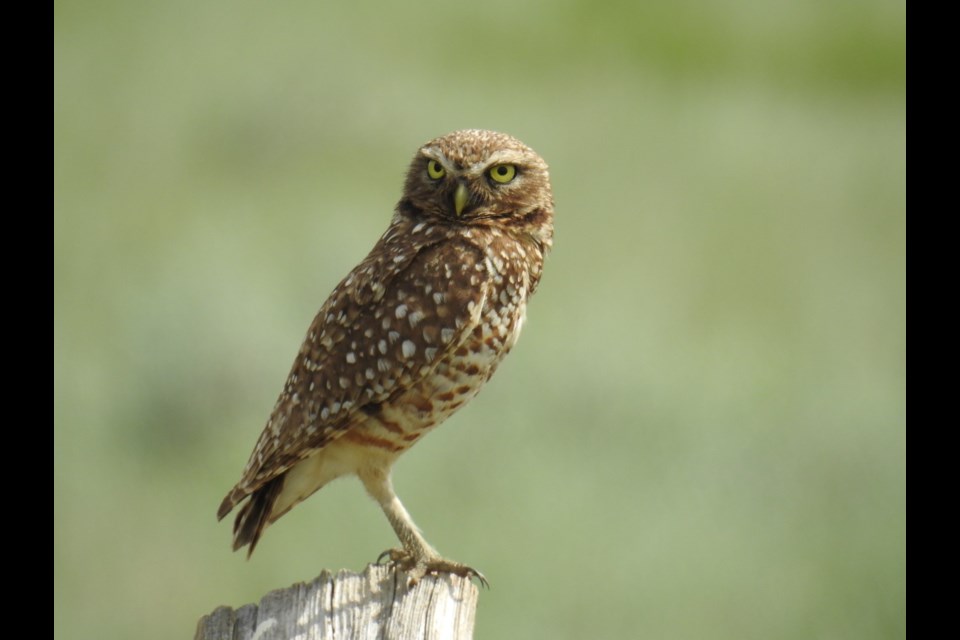REGINA — It’s that time of year again when the endangered Burrowing Owl returns to the prairies from their wintering grounds in southern Texas and Mexico.
By now, the males have chosen a burrow and stocked it up with mice and other prey to impress their future mates. From mid-May to mid-June, these little owls are starting the mating process, finding a home, and laying and incubating their eggs.
Burrowing owls are identifiable by their small size (approximately nine inches tall) and light and dark brown mottled plumage with white spots. They have a round head, with large yellow eyes, and white ‘eyebrows’. Another characteristic feature is their long, featherless legs, which gives them the appearance of walking on stilts. During mating season, females will listen for the “coo-coooo” call of the males. Burrowing owls also make a chattering or chuckling call.
Despite their name, Burrowing Owls do not dig their nests themselves. Instead, they use abandoned burrows that have been previously used by burrowing mammals such as badgers or ground squirrels (gophers). Burrowing Owls choose to nest in several different habitat types. Most nest burrows occur in grazed native or tame grassland pastures, but they have been known to be found in cropland. “Grazing is very beneficial to the Burrowing Owl”, Grace Pidborchynski, Habitat Stewardship Coordinator at Nature Saskatchewan explains. “On grazed pastures, the shorter grass helps these owls detect potential predators more effectively. In addition, the owls use manure in and around their nests to absorb excess moisture, regulate burrow temperature, attract insects for food, and hide their scent from predators.” During the nesting season, male burrowing owls can often be seen on lookouts next to their burrows, or on nearby fence posts while the female incubates the eggs.
Burrowing owls are generalist predators, meaning they will prey on anything small enough for them to catch. They will hunt prey that is most readily available to them, such as mice in the early spring, and grasshoppers in the late summer. Burrowing owls are most active during the day; especially when the male is busy gathering food for his family in the spring and early summer. There are several techniques to which Burrowing Owls hunt, such as hovering above the ground and pouncing, perching from a fence post or mound, running after insects, and catching insects mid-air with their talons. A Burrowing Owl family can eat 1,800 rodents and 7,000 grasshoppers during a single summer, making them great pest control!
Each spring, female Burrowing Owls will lay between 6 and 12 eggs. Because there are thought to be less than 300 pairs nesting throughout Canada, the success of each nest is important to the survival and recovery of this species. Nature Saskatchewan’s stewardship program, Operation Burrowing Owl, works with landholders to conserve and enhance Burrowing Owl habitat and monitors Burrowing Owl numbers at participating sites. “We are very fortunate to have so many passionate landholders and land managers participating in the program and keeping an eye out for Burrowing Owls,” says Pidborchynski. Operation Burrowing Owl records sightings to help determine the population trend and distribution of the Burrowing Owl throughout Saskatchewan. “Without help from landholders and the public, recovery of this unique prairie owl would not be possible,” says Pidborchynski. If you are lucky enough to see a Burrowing Owl, she asks that you call Nature Saskatchewan’s toll-free HOOT Line, 1-800-667-HOOT (4668) or email [email protected]. “When you report a sighting you are playing an important role in Burrowing Owl recovery. Every sighting is critical!” says Pidborchynski. Personal information is kept confidential and is never shared without permission.




